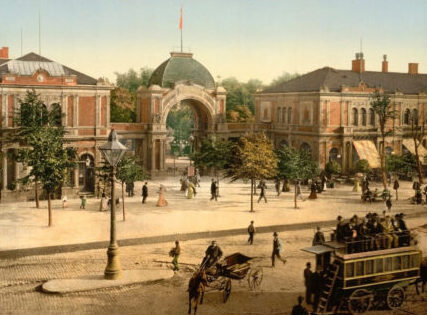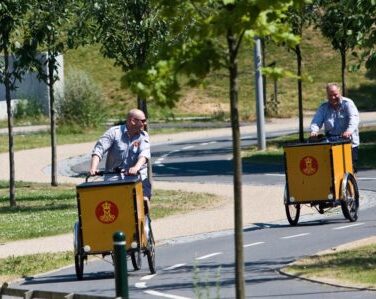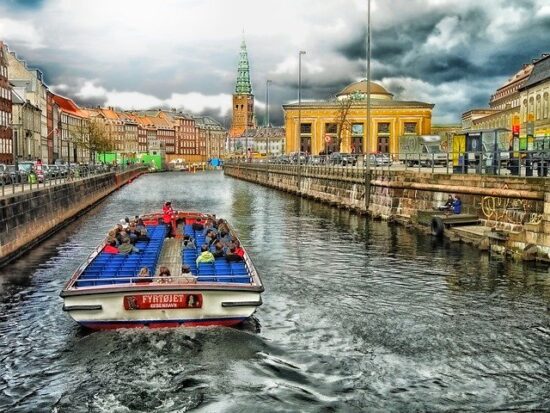Maturity
Due to the economic downturn, the notable architectural works of the first 40 years of the 1800s were restricted to the projects undertaken by Christian Frederik Hansen like the Domhuset (Town Hall until 1900, later House of the City Council) at Nytorv, the Metropolitan School on Nørrebro and of course his major reconstructions of the Cathedral of Vor Frue Kirke and Christiansborg Palace. All of his works followed the same lines of the austere Neoclassical style that had become popular in Europe after the mid-18th century.



The industrialization that had shyly come to the fore with the introduction of the steamship in 1820 was intensified after 1840. In 1847 the country’s first railway opened between Copenhagen and Roskilde, Carlsberg Brewery and Burmeister Machine Company were founded and the first steam engines were installed in Copenhagen’s clothing factory.
By 1855 the use of steam engines and mechanical power in several industries was predominant. Economic recovery created new jobs and a further increase in population (120.000 in 1840, 160.000 in 1860) which led to stifling conditions and sanitary problems that resulted in a cholera epidemic in 1853 that claimed the lives of nearly 4.000 people.



The cholera epidemic became the catalyst for a more liberal urban plan that permitted housing beyond the narrow borders of the city’s walls towards the end of the 1850s. There was an immediate building boom with new populous neighborhoods like Nørrebro, Vesterbro, and Frederiksberg sprouting outside the ramparts that were completely removed towards the end of the 1860s.
New spacious parks like the Tivoli Gardens, Ørstedsparken, Botanisk Have, and Aborreparken gave Copenhageners a quick way out to nature as did the capital’s first Zoo that opened its gates in 1859.New museums like the Thorvaldsen Museum dedicated to the art of Danish Neoclassicist sculptor Bertel Thorvaldsen (1770–1844), the National Museum of Art, and Ny Carlsberg Glyptotek opened to the public.
New theaters like Dagmarteatret, the National Scala, and Folketeatret, and new amusements like Cirkusbygningen were developed. The Library of Copenhagen’s University moved into new premises at Fiolstræde. It was one of the most active periods in Copenhagen’s construction history.



By the year 1900, the extent of the municipality had tripled and the population had soared to half a million people. Copenhagen was now a constantly growing European metropolis, an administrative and industrial center with electric plants and trams, telephones, a new modern port (Frihavn), and a grid of new roads lit by new electric street lights and roamed around by the first motor vehicles. It was a brave new world and Copenhagen was very much part of it.



Copenhagen’s growth and modernization continued well into the 20th century despite the intervals of a housing and banking crisis in 1908 and of course WWI which did not directly affect the city due to the country’s neutrality but never shortages in most goods and a spike in unemployment.
In 1910 the first bicycle lanes are established in the capital and the first ever Bike Messenger Company (By-Expressen) sets up its first routes.
Two years later the first ocean-going diesel-powered ship ever built the M/S Selandia starts her maiden voyage from Copenhagen to Bangkok. In architecture, the first quarter of the 20th century was imprinted by the inauguration of the impressive new Town Hall and its surrounding square and the completion of the imposing Central Railway Station in 1917.



By the 1930s the population had surpassed the number of 800.000 inhabitants. One of the first civil airports in the world (Kastrup) had started its operation, a public radio broadcast had entered the lives of Copenhageners and public transport had been expanded to include most areas of the capital.
The new suburbs had formed market towns of their own while the housing market continued to have its ups and downs, as did the economy that fell in a whirlwind of the 1929 crash during the first years of the 1930s. The collapse of foreign trade had a serious effect on the city’s unemployment rates which were raised to a concerning height. The overall economic stagnation lasted until the occupation of Copenhagen by the Nazis which began on 9 April 1940.



In the beginning, the German occupation lacked the ferocity showcased in different countries due to the Nazi race ideology that categorized the Danes as “fellow Nordic Aryans”, along with Hitler’s hopes of running Denmark as a model protectorate and the support given by many Danes of German descent and far-right ideology.
Denmark retained its government and its king with the latter soon becoming a symbol of national sovereignty for the Danes and Copenhageners flocking to cheer and applaud every time he went on the streets of the capital with his horse.


Things escalated after 1943. Germany took complete control of the country and what followed was more or less what happened to all occupied countries. Censorship, curfew, strike ban, communist and Jewish persecution. Many buildings were destroyed by Germans or Allied bombings and occasional sabotage by the resistance.
Nevertheless, the overall damage to the city and its infrastructure was inconsequential compared to what happened in many European cities at the time. On 5 May 1945, Copenhagen was liberated by the English troops that liberated the country. The first weeks of freedom were celebrated with enthusiasm and exuberance. On October 30, the first post-war parliamentary elections were held with the left and Knud Kristensen forming the first government.


After 1947 the city entered a phase of innovative urban development with new schools, nurseries, sports facilities & hospitals established all over Copenhagen. The 1950s brought the inauguration of the first skyscraper and the first freeway and in the 60’s the world’s largest pedestrian shopping street Strøget.



In the ’70s the population of the urban area of Copenhagen went above 1.250.000 people. In 1971, 150 people moved into the area of Christiania a former “Forbidden City of the Military” and established their self-proclaimed anarchist community. It was a diverse group of hippies, artists, homeless, and drug addicts flowing towards the area to realize a dream of life-based on freedom, creativity, and community.
The residents called the new district the Freetown of Christiania, and September 26th, 1971 was proclaimed its official birthday. In 1989 the anarchist district was legally acknowledged by the government, and in 2004 the Parliament passed a new law on the normalization and development of the district by a large majority. In 2012 about 900 people lived in Christiania. The area is visited annually by up to half a million tourists.



From the 1970s to the 1980s, several conflicts arose between bicycle and car interests in Danish cities. One example was the wave of popular protests which followed in the wake of a proposal from the Copenhagen authorities to establish a motorway across the lakes which separate the inner city of olden times from the more recent suburban districts. There was an enormous outcry because, then as now, the lakes were some of the city’s loveliest open spaces.
Gradually it became clear to most people that the solution to the problems had to be city planning that gave space to cars, bicycles, pedestrians, and public transport. Out of this realization grew the Danish model with its extended network of cycle lanes along the roads, which continues to be further developed. (source http://www.cycling-embassy.dk/2016/01/18/how-denmark-become-a-cycling-nation/)
In the 1980s and 1990s, large-scale restoration work in the historic districts and an urban renewal took place with the concern for the environment being an integral part of those projects at a time when the environment was not a real priority in most cities. Car traffic subsided in favor of pedestrian streets, the metro was inaugurated and a new route of cycle routes increased the number of cyclists entering the inner city to 40% of the overall entries by 2000.



In the ’00s Copenhagen entered a new era of growth with the construction of iconic new landmarks like the Black Diamond library, the 8 km (5 ml) Øresund Bridge that connects the capital to Malmö, (Sweden), the new Opera House (Opera) and the Royal Danish Playhouse.
The City of Copenhagen is constantly within the first places worldwide in the various international rankings of urban quality of life, it has a constantly growing number of tourists and students, a vibrant cultural life, and 1.3 million permanent residents.



Copenhagen is a bright example of an environmentally friendly capital, a model of a sustainable megalopolis that raises the bar for the rest of cities of the developed world, a city that has already transcended into the era of the green economy and climate change. Most of all the Danish capital is a city that beams with optimism and confidence for a future that will most probably be even greater than its past.





